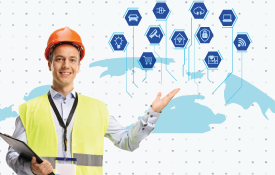The modern manufacturing and construction workforce is changing. It’s more diverse and dynamic than ever before — and the imperative to properly train and retain that workforce has never been higher. Worker turnover is at record levels—and industries with a greater injury potential lead that list.
While traditional analog methods are no longer sufficient to meet rising standards for workplace safety, technology such as IoT-enabled sensors, wearable devices and eXtended reality can help fill that void.
Keeping worker safety at the center
Workers in heavy industries such as manufacturing, mining, and construction are exposed to a litany of hazards during every shift: chemicals can be inhaled, persistent noise can lead to long-term hearing damage, and fall-related risks are a mainstay. Despite carefully written safety procedures, workers can quickly become complacent with personal protective equipment (PPE). And sometimes, workers might not even be aware of the risks or damage until health problems arise years down the line.
According to a 2020 report from the Bureau of Labor Statistics (the most recent period for which data is available), the construction sector in the US reported 74,520 nonfatal injuries in that calendar year. Over that same time period, manufacturing workers (across all sectors) accounted for 135,900 nonfatal injuries. The reality is that workplace injuries do happen, but IoT, wearables, and cloud technologies can improve workforce safety and retention.
Monitoring safety conditions can introduce additional logistic challenges; it’s not feasible to ensure that every worker is in compliance at every moment, and self-reporting measures may fall short.
Refined tracking with IoT devices
IoT technologies connect seemingly mundane devices with one another and give end users the ability to track and control the world around them from their fingertips. We’re accustomed to these solutions in smart home devices—where we can now unlock the front door or raise the temperature on the thermostat—all from the couch. But in the industry, the applications are endless. IoT devices allow enterprises to track every aspect of the manufacturing process, from precise temperature readouts to advanced supply chain tracking. These solutions have largely focused on throughput for the manufacturing and construction process, and not on ancillary objectives such as worker safety.
Worker NxT from Mindtree changes that paradigm. To date, Mindtree has onboarded nearly 1.5 million workers at more than 300 locations. Data on those workers is tracked in a multitude of ways to help improve safety.
Download white paper to know more
